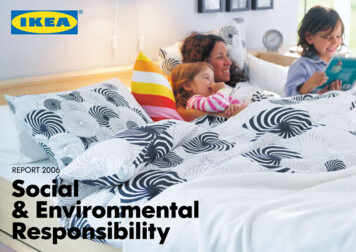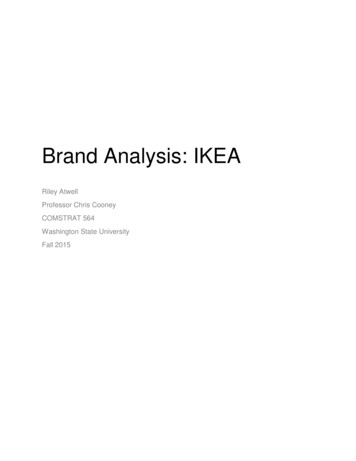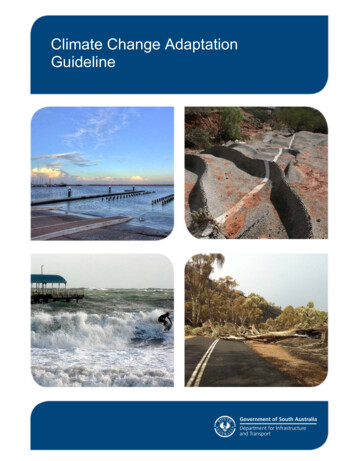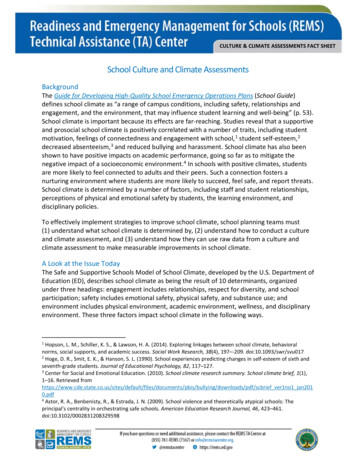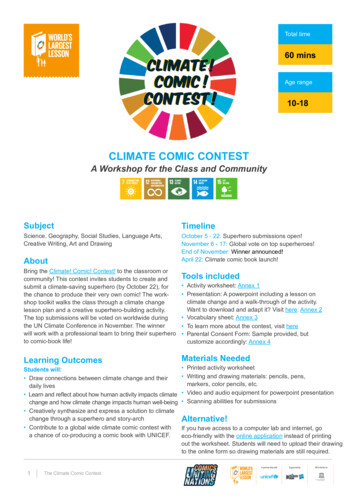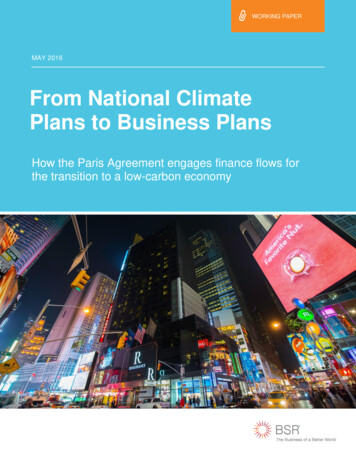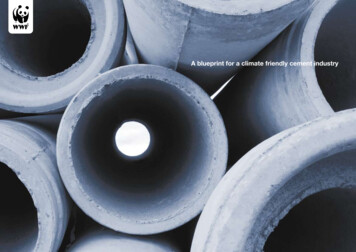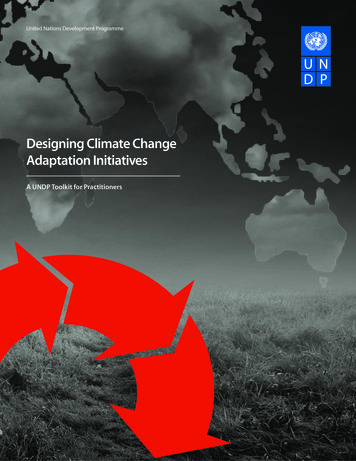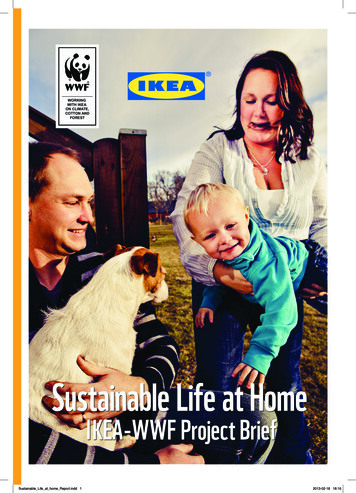
Transcription
WORKINGWITH IKEAON CLIMATE,COTTON ANDFORESTSustainable Life at HomeIKEA - WWF Project BriefSustainable Life at home Report.indd 12013-02-18 18:16
Content:1 Introduction: WWF IKEA Climate projects 32 The project: Sustainable life at home – Swedish pilot 53 High level findings11ContactVärldsnaturfonden WWFUlriksdals Slott, 170 81 SolnaTelephone 46 8 624 74 00info@wwf.seIKEA Svenska Försäljnings ABBox 200260 35 Ödåkraprse@ikea.comWWF IKEA PartnershipIKEA and WWF share common interests, particularly in seeing the considerate,efficient, long-term economically sound use of natural resources and ensuringthat the use of renewable natural resources is sustainable.The Partnership, started in 2002, is founded on each partner’s uniquecompetencies and we now work together in 16 countries around the world topromote responsible and sustainable use of resources. The partnership focuseson three areas; climate change, cotton and forest.In addition to working together in projects, WWF and IKEA want to inspireother companies and networks to address environmental challenges and makepeople’s lives at home more sustainable.By working together we accomplish more!2WWF IKEA Partnership - Sustainable Life at HomeSustainable Life at home Report.indd 22013-02-18 18:16
1. WWF IKEAClimate projectsIKEA and WWF have identifiedclimate change as one of the majorglobal challenges and startedcooperating to tackle this in 2007.The partnership has workedtogether in six joint climate projects to identify barriersand develop tools and innovative solutions to reduceemissions of greenhouse gases (GHG).The aim of the climate projects has been to findmarket transformation opportunities, identify lowcarbon solutions that can contribute to reducingGHG emissions in society, and engage stakeholdersthroughout the IKEA value chain. This is why theprojects have covered a wide range of aspects,including product development, supplier operations,transportation, customer behaviour and recycling.As part of the climate projects, calculations were madeto estimate how much positive impact IKEA could have,mainly by introducing new innovative products andby inspiring customers to live a more sustainable lifeat home. Since IKEA has a large number of customers,even small individual changes have a large total impact– for example when people reduce their food waste,move towards vegetarian food, start using energyswitches and LED lighting, etc.WWF IKEA Partnership - Sustainable Life at HomeSustainable Life at home Report.indd 332013-02-18 18:16
Why is it important to inspire people to live more sustainably at home?There are billions of people who want to live more sustainably and consume in amore sustainable way. Many want to contribute to a better future but may find it hardto know how to live with as little impact on the environment as possible. At the sametime, many people are not willing to sacrifice their everyday comfort. So ideally,sustainability should not affect daily life, cost more or take extra time. Theserestrictions make it relevant to ask is if it is really possible to find ways to live moresustainably? And is it possible for the individual to make a difference with smallmeans and actually contribute to a better environment?According to WWF’s Living Planet Report 20121, the immediate focus must be ondrastically shrinking the ecological footprint of high-income populations –particularly their carbon footprint. It is important to identify how the individual cancontribute to this big picture and it is important for decision makers and companiesto provide conditions for people to do so.Around one quarter of the total carbon footprint from the IKEA value chain comesfrom the use of its products in customers’ homes. This is why it is important forIKEA to enable its customers to reduce their carbon emissions by providing inspiringinformation and solutions that can help them. In addition to this, IKEA is committedto developing more sustainable products, moving towards energy and resourceindependence and contributing to a better life for people and communities. (You canread more about this in People & Planet Positive, the IKEA Group sustainabilitydirection for 2020, which can be found on IKEA.com.)With this background, IKEA and WWF decided to collaborate in a project with theobjective to find ways of helping and inspiring people to live a more sustainable life athome and thereby reduce their environmental impact – and do this withoutcompromising too much with everyday routines, and without adding extra costs andtime.The Ecorationblog becamethe information hubfor the project. Herethe general public andpeople interested in theissues could follow thefamilies throughout theproject and get inspiredby their engagementand solutions.14Please see www.panda.orgWWF IKEA Partnership - Sustainable Life at HomeSustainable Life at home Report.indd 42013-02-18 18:16
2. Sustainable lifeat homeOver a six-month period, IKEA andWWF supported nine families –Ecoration families – in Kalmar,Sweden, to test out a wide variety ofsolutions to save energy and waterand minimise waste that together with changedbehaviours would enable customers to live a moresustainable life at home.The nine selected households come from different backgrounds and represent a widerange of family constellations, living- and housing situations – reflecting modernsociety in Sweden. Their level of knowledge of environmental issues varied, but theyall shared an interest in learning more about sustainable living.The goals with the project were to: Identify the relevant family needs and challenges, find solutions and methods toenable them to live more sustainably, and measure the effect Find ways to spread the families’ experiences and insights and thereby inspireother customers to live a more sustainable life at home. Based on the families’ input, spark ideas to future product developmentThe cooperation with the families ended in June, 2012. This report presents the mainresults and findings, and summarises how IKEA and WWF can use the lessonslearned.PROJECT ACTIVITIES 8 home visits per family, including implementation of home furnishing solutionsfor a more sustainable life at home In-store seminars for the families on relevant topics Online communication trough the blog IKEA.se/ecoration, Facebook,livethemma.se and WWF.se In-store communication using the families’ testimonials together with IKEAsolutions Tests of tools to measure the effect of avoided waste, saved energy, saved waterand the families’ overall feeling of well-being Distribution of inspirational images and stories to home furnishing bloggers andjournalists 4 press releases to journalists Seminar for journalists, bloggers and opinion leaders within sustainable lifestyle, home furnishing and designWWF IKEA Partnership - Sustainable Life at HomeSustainable Life at home Report.indd 552013-02-18 18:16
OPPORTUNITIESIn 2011, a study performed by the research company Lippincott showed that 72% ofconsumers in Sweden care about sustainability and 43% say they could do more.According to the study, IKEA customers want IKEA to help them to make sustainablechoices, without compromising on quality or paying more. This shows that there is ademand for information, products, services and solutions that help people live amore sustainable life and reduce their environmental impact.The families in Kalmar have proved that there are no major barriers for people tostart living more sustainably, but they need guidance on how to take the first steps. Ifa big company like IKEA provided its customers with solutions and inspired them tochange their behaviour, many would be able to reduce their environmental impact.And when made by many people, even small changes can have a substantial, globalimpact.The study IKEAs opportunities to influence C02 emissions in society, conducted byIKEA and WWF in 2010-11, examined several different scenarios. For example; if25% of all IKEA customers worldwide reduced their food waste by just 14% 1, it couldreduce CO2 emissions by 6 million tonnes – equivalent to taking around 3.5 millioncars off the road ( a conservative estimate is that an average car in Sweden emitsabout 1.7 tonnes CO2/year). And if 25 % of all IKEA customers would eat vegetarianfood just one day a week, it would correspond to a reduction of 12 million tonnes ofCO2 per year. If 50% of IKEA customers started using stand-by switches for TVs,computers and the like, it could cut CO2 emissions by 28 million tonnes per year –equivalent to taking around 16.5 million cars off the road.Customer interest and the above examples of how small but important changes madeby many people can create a big impact show the great potential in inspiring IKEAand more companies to engage with their customers to live a more sustainable life athome. There are many opportunities to make a difference within the areas of waste,energy and water – the three areas that the project focused on – and our joint effortshave been limited to direct activities in the home where IKEA and WWF can provideknowledge, solutions and products.MEASURED RESULTSThe nine families measured their waste and electricity reductions over a five-monthperiod. They also measured their total carbon emission when the project started andwhen the project ended. Saving water was another focus area, but the project did notfind a simple way to measure how much water each household was able to save.Through qualitative interviews and blogs, the families shared how this way of livingaffected their feeling of well-being, their behaviour and attitudes towardsenvironmental issues and consumption in general.16UK-based WRAP (www.wrap.org.uk) estimates that this 14% waste reduction can be done “fairly easily”WWF IKEA Partnership - Sustainable Life at HomeSustainable Life at home Report.indd 62013-02-18 18:16
Well-beingThe overall feeling of well-being families reported was boosted by the satisfaction ofactually doing something concrete to reduce their environmental impact, and bybeing good examples for children and thereby introducing a way of living that willbecome a natural part of their adulthood. Another motivator was to takeresponsibility for the future and future generations. It was also a relief for many ofthe families to get organised and to discover attractive, functional and effectivesolutions for recycling, cooking, drying washing, etc. These motivators were highlyimportant to the families and can be summarised in a few quotes: ”It’s my duty to do something for myself and for my children.” ”I have the possibility to influence my children’s behaviour – something they willkeep throughout their life.” ”It’s more fun to recycle with nice solutions.” ”With increased knowledge, I can share my experiences with others.”Reductions – non-recyclable wasteSome families reduced their non-recyclable waste with as much as 70% and otherswith 15%. Some of the families had very small amounts of non-recyclable wastealready from the beginning, but the average waste reduction at the end of the projectstill amounted to approximately 30%.The good result is mainly due to the fact that the families were supported withrecycling solutions that were completely adapted to their individual needs, enablingthem to recycle everything possible. Another factor behind the result was that somefamilies did not sort everything before the project started as Kalmar municipalitydoes not offer full recycling as part of their regular waste management service tohouseholds. As a result of the project, one family now takes recycled waste in smallbags on their bicycles to the municipal recycling station instead of using large binsthat would need to be transported by car. And with recycling solutions that are veryeasy to handle for children, a male single parent that took part in the project now hasgood help from his sons and a new behaviour has been established in the family.All families have become conscious not to throw food away, and some families testeda solution for indoor composting. One family reduced foodwaste with more than40%. The reduced amount of food waste significantly reduced the overall amount ofunsorted (non-recyclable) waste generated by the families.WWF IKEA Partnership - Sustainable Life at HomeSustainable Life at home Report.indd 772013-02-18 18:16
Reductions - electricityThe nine households’ average electricity consumption fell by 30 % over the projectperiod from January to March. When comparing consumption year on year (March2012/2011), the average electricity use decreased by 20%, not taking temperaturedifferences between the two periods into account. Results were measured with thehelp of an energy visualisation tool and an independent energy consultant.A main contributor to the decrease was the change to LED bulbs throughout thefamilies’ homes. One project family member, working at Kalmar Energy, did his owncalculation; If 30 000 households in Kalmar changed their traditional incandescent40W bulbs to 5W LED bulbs, the savings would be enough to provide 400 villas inKalmar with household electricity during a whole year. And every household wouldsave 45 SEK/year on each light source that is changed to LED, based on three hoursuse per day.Two of the project families that reduced their electricity consumption by 30% and20% respectively reported that changed behaviour was of great importance. Today,they always switch off the light when leaving a room, they don’t use the tumble drier,they cook more efficiently with pressure cookers and steamers and use residual heaton the stove, etc.The families hadLED lights installed.They reduced theirelectricity consumtionand improved theathmosphere oftheir homes at thesame time.Reductions - total carbon emissionEven if the project focused on activities in the home, the families’ growing overallconsciousness of sustainable living affected other areas, including transportation,travel, choice of food, reuse, etc. To highlight one example, this increased environmentalawareness was reflected in one family’s decision to buy a car fuelled by biogas.To be able to measure improvements, each family calculated their total carbonfootprint at the start and at the end of the project. They did this by using an Internetbased tool 1 to measure how a household’s consumption affects the environment. Theaverage carbon footprint per person in Sweden is 5.8 tonnes of CO2 per year. Thefamilies’ average footprint was below the Swedish average already at the start of18www.ecorunner.industrialecology.seWWF IKEA Partnership - Sustainable Life at HomeSustainable Life at home Report.indd 82013-02-18 18:16
the project, and when they entered their consumption data into the tool at the end ofthe project their group average footprint was 4.3 tonnes CO2 per person per year,with a wide span between different households. The main purpose of measuring thecarbon footprint was to get an overall understanding of the environmental impact ofthe households’ consumption.The CO2 footprint was divided into four key areas: home & living, householdpurchases, transportation and leisure. Those with the lowest CO2 footprint managedto reduce emissions related to leisure activities, transportation and – to a largeextent – home & living. Meanwhile, it was the footprint generated from transportationand home & living that boosted the total figure for families with the highest CO2footprint.Time savingsThe most obvious time-saving solutions for families that want to live moresustainably at home are the pressure cooker and the steamer. The families who usedthe pressure cooker during the project now say they cannot manage without it. Theysave up to 20 minutes every time they cook rice, potatoes, beans and such, whichmakes it easier to cook more time consuming meals also on weeknights. A femaleproject family member, a dedicated amateur chef, calculated that she saves 48 hoursper year with the pressure cooker.The families also save time with the help of smart solutions that make it easy to takerecycled waste to the recycling station on their way to work – it is no longer atime-consuming effort done twice a month as it often was before.However, the end result is less about saving time and more about not adding to theoverall time needed to do household chores more sustainably – for example airdrying the washing instead of using the tumble dryer, reusing water used for rinsingvegetables to water the flowers and composting food waste instead of throwing it inthe residual waste. Because the new solutions at home were tailored to each family’sindividual needs, the families say that these new activities have not required extratime, and that it feels natural to continue with the new and more sustainable habits.Picture 1: Pressurecookers savedtime and money.Picture 2: Clotheswere air driedto save power.WWF IKEA Partnership - Sustainable Life at HomeSustainable Life at home Report.indd 992013-02-18 18:16
Reduced costsCost savings are an obvious result of significantly reducing the amount of nonrecyclable waste and electricity consumption.Reducing a household’s waste with up to 70% means that a family living in a housecan subscribe to the waste management company’s smaller bins. This represents acost saving of approximately 9001 SEK per year.Reducing the electricity use by around 30% represents a cost saving of approximately7,500 2 SEK per year for a household that consumes 25,000 kWh per year at a fixedprice of 1.00 SEK/kWh.Picture 1: Onehousehold reducedtheir waste with 70%.They recycled moreand started compostingorganic waste.Picture 2: Everyonecan create their ownwaste sorting solutionusing old as well as newbuckets and bins.1210www.infomix.sewww.kalmarenergi.seWWF IKEA Partnership - Sustainable Life at HomeSustainable Life at home Report.indd 102013-02-18 18:16
3. HIGH LEVELFINDINGSThe Sustainable life at home projecthas showed that it is possible forcompanies like IKEA to contributeto significantly reduced emissionsgenerated by its customers and tolook beyond its own operations. Inthis project, it was done by influencing, inspiring,helping and informing customers to a more sustainablelife at home.In addition, IKEA should continue its work to improve the entire product range. With190 million customers every year, IKEA has great potential to reduce their downstreamemissions from the product range and avoid customer emissions through, for example,changed behaviour. It is possible for companies to reduce emission generated by their customers, i.e.avoided emissions. Increased knowledge and understanding is a first step that provides motivationfor behavioural change and new solutions. IKEA may play a role in increasingthe demand for more sustainable products and solutions by involvingcustomers, as it did in in this project. Living a more sustainable life at home is a platform for taking furthersteps: A key learning point from the families in Kalmar is that when they havestarted to live more sustainably in one area, for example recycling, this becomes amotivator to think about sustainability in other areas as well. Several families nowshop food when needed instead of once a week, and have reduced their food wastesignificantly. Some are more conscious about travel and will consider the environmental aspect when buying the next car. Many consider reuse as an alternative tobuying new things, and some eat less meat and buy more ecological food. It is important to measure and visualise improvements in order tomotivate changed behaviour. When it comes to recycling, it is obvious that thenon-recyclable waste decreases and this is a clear motivator. But when it comesto energy and water, it is not possible to see the everyday reductions unless thereis a way to visualise them. The project tested the ELIQ1 energy display, as avisualisation tool for everyday electricity consumption, and the use was criticalin order to encourage changed behaviour -- turning down the heating, switchingoff the light when not in the room, air-drying the washing instead of using thetumble dryer, using the stove more efficiently, etc. Consultancy services, such asenergy audits, are also important to develop an overall understanding of theoverall energy use of the house. As the project was not able to measure waterreductions, it proved more difficult to motivate the participants to save water. Grandma’s behaviour was right and with today’s solutions it’s easy todo the right thing: This project has demonstrated that behaviours that wereplain common sense 70 years ago need to be highlighted again in combinationwith new solutions and products. Living more sustainably at home does not haveto be high-tech, difficult and expensive. Everyone can start now, in their ownhome.1www.eliq.seWWF IKEA Partnership - Sustainable Life at HomeSustainable Life at home Report.indd 11112013-02-18 18:16
12 Interaction and sharing with others – “new behaviour x many people huge impact”: The possibility to interact, share and discuss with others iscritical in order to encourage individuals to contribute with a small part with thepurpose to make a big difference together with many others. One success factorin this project was the creation of an online platform (www.IKEA.se/ecoration),a blog where customers interacted with each other and where IKEA togetherwith WWF and other opinion leaders shared knowledge and inspiration for howto live a more sustainable life at home. The right solutions are important enablers for a changed behaviour:If people are to continue to live more sustainably at home, the solutions at homemust fulfil their needs – they must be very simple, easy to begin with, not takeextra time and make it possible for the whole family to contribute. When itcomes to recycling, this means that it is important to not only think about how tobest recycle at home, but also how to transport recyclable waste to the recyclingcollection point or station. Products are part of a solution that together withinsight and motivation will result in changed behaviour. “Customers talking to customers” create credibility in-store andonline; In the IKEA Kalmar store customers could follow the families throughtestimonials connected to displayed home furnishing solutions for a moresustainable living, based on the solutions in the families’ homes. Online, thefamilies shared their experiences by blogging. From a customer point of view,this creates more credibility than if IKEA was the only source of sustainablehome furnishing advice.WWF IKEA Partnership - Sustainable Life at HomeSustainable Life at home Report.indd 122013-02-18 18:16
Concluding seminar October 30, 2012A seminar was conducted in Stockholm, Sweden onOctober 30, 2012, to report on the ‘‘Sustainable life athome/Ecoration’’ experiment. Approximately 100journalists, bloggers and opinion leaders attended theseminar to discuss how businesses and consumerstogether can help reduce the ecological footprint.The Ecoration project served as the basis for thediscussion. IKEA, WWF and representatives from theKalmar families shared their insights, visions and keylearning points. The participants were encouraged toshare what they think big companies like IKEA shoulddo to make sustainable living easier. A short workshopwas conducted and some comments are summarised inthe quotes and the image below:‘‘We wish big companies like IKEA would make bad things more expensive (and keep goodthings cheap).’’ make all products sustainable without me knowinghow and why, I do not have to know every detail aboutthe product/service to make a sustainable choice.’’ make it easier to consume less goods and instead useenvironmentally friendly services.’’ provide transparent information on recyclability,constituents, origin, life-cycle energy-use, footprints,etc.’’. nudge with environmentally smart products . (easyfor the customer to choose).’’. have more vegetarian options than meat options in thestore.’’WWF IKEA Partnership - Sustainable Life at HomeSustainable Life at home Report.indd 13132013-02-18 18:16
Sustainable life at home - China pilotIKEA and WWF has also worked with IKEA co-workers in Shanghai, China, to learnfrom them and inspire them to live more a sustainable life at home and at work. Tenco-workers’ families were recruited to develop individual improvement plans focusedon energy use and an “Eco-house” was created in the IKEA store. This small exhibitiondisplayed the families’ results in order to inspire other co-workers, and at the endof the pilot more than 100 pieces of advice (incl. on how to reduce food waste in thestaff canteen) had been collected from co-workers for co-workers, engaging them inactions at the workplace to reduce environmental impact. The result from this projectis presented separately.Read more14 Ecoration 2012 brochure – home furnishings and inspiration for a new andgreen life at home can be found on panda.org/ikea Movie from the Ecoration seminar can be found on livethemma.ikea.se/ecoration Co-workers handbook and Sustainable life at home toolkit from China projectcan be found on panda.org/ikaWWF IKEA Partnership - Sustainable Life at HomeSustainable Life at home Report.indd 142013-02-18 18:16
NotesWWF IKEA Partnership - Sustainable Life at HomeSustainable Life at home Report.indd 15152013-02-18 18:16
FSCPAPER FROMMIXEDSOURCESSustainable Life at Home IKEA - WWF Project Briefloggorhög – 59%Minst 12 mm hög – 59%Minst 12 mm hög – 59%Minst 12 mm hög – 59%igg höjd 12mm cmyk.epsvit gröntext ligg höjd 12mm cmyk.epssv vit text ligg höjd12mm sv cmyk.epsvit sv text ligg höjd12mm cmyk.epsbred – 38%Minst 17 mm bred – 38%Minst 17 mm bred – 38%Minst 17 mm bred – 38%tå br17mm cmyk.epsvit gröntext stå br 17mm cmyk.epssvart vit text stå br 17mm cmyk.epsvit sv text stå br 17mm cmyk.epsloggor engelsk text (text med fler språk finns att ladda ner på http://info.fsc.org)hög – 59%Minst 12 mm hög – 59%Minst 12 mm hög – 59%Minst 12 mm hög – 59%igg höjd12mm cmyk.epsvit grön text ligg höjd12mm cmyk.epssv vit text ligg höjd12mm EU cmyk.epsvit sv text ligg höjd12mm EU cmyk.epsbred – 38%Minst 17 mm bred – 38%Minst 17 mm bred – 38%Minst 17 mm bred – 38%t br17mm cmyk.epsWORKINGWITH IKEAON CLIMATE,COTTON ANDvit grön text st br17mm cmyk.epsFORESTsv vit text st br17mm cmyk.epsPrinted on avit sv text st br17mm cmyk.epsClimate Neutral company,Edita Västra Aros 2012oggor engelsk text (text med fler språk finns att ladda ner på http://info.fsc.org)hög – 59%Minst 12 mm hög – 59%Sustainable Life at home Report.indd 16Minst 12 mm hög – 59%Minst 12 mm hög – 59%2013-02-18 18:16
a big company like IKEA provided its customers with solutions and inspired them to change their behaviour, many would be able to reduce their environmental impact. And when made by many people, even small changes can have a substantial, global impact. The study IKEAs opportunities to
